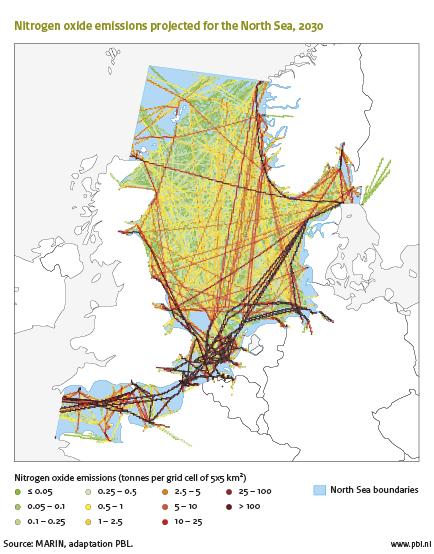Assessment of the environmental impacts and health benefits of a nitrogen emission control area in the North Sea
Two studies have analysed the costs and benefits of creating a nitrogen emission control area in the North Sea and the English Channel. Such a control area requires new ships to emit 75 percent less in nitrogen oxide, from 2016 onwards. This is expected to lead to substantial benefits for health and nature.
Benefits of nitrogen reductions in North Sea shipping exceed costs
The health benefits of a nitrogen oxide emission control area in the North Sea, from 2016 onwards, would exceed the costs to international shipping. Such an area leads to reduced levels of nitrogen dioxide, ozone, and particulate matter (PM2.5) in the surrounding countries and to reduced associated negative health impacts. It also contributes to less nitrogen deposition and fewer impacts to nature. In addition to such an air measure at sea, effective air measures may also be taken on land, in agriculture and industry, which would yield higher benefits to health and nature against lower costs. A nitrogen emission control area, therefore, seems to fit a somewhat wider ambition to improve air quality in the North Sea region.
Policy process around a nitrogen emission control area in the North Sea
These are the main conclusions from two impact assessments – one of which looked at environmental effects and the other at economic effects – which were commissioned by the eight North Sea countries of Belgium, Denmark, France, Germany, the Netherlands, Norway, Sweden and the United Kingdom. The assessments were conducted with the aim to support the decision-making process in these countries around a joint application to the International Maritime Organization for designation of the North Sea (including the English Channel) as a nitrogen emission control area.
What is a nitrogen emission control area?
In a nitrogen emission control area, all new ships (built after 2015) would be required to reduce their nitrogen oxide emissions by 75 per cent, compared to current emission standards for international shipping. Because of the relatively slow replacement rate of ships, the assessments focused on impacts in the year 2030. By 2030, between 35% and 65% of the different ship types will consist of ships built after 2015. Somewhere between 2040 and 2050, all ships are expected to have been built after 2030, and to meet the stringent nitrogen emission standards.
The North Sea is already designated as a sulphur emission control area
The North Sea is already designated as a sulphur emission control area, which requires ships to use low sulphur fuels or exhaust gas scrubbers that remove sulphur dioxide. Such low-sulphur fuels or scrubbers also result in substantial reductions in particulate matter emissions.
How much will North Sea shipping contribute to air pollution in 2030?
The North Sea, including the English Channel, is one of the busiest seas in the world. Major shipping lanes can be clearly identified on the map showing the nitrogen oxide emissions from North Sea shipping projected for 2030. By that year, nitrogen oxide emissions from North Sea shipping are expected to be responsible for 7 per cent to 24 per cent of average nitrogen dioxide concentrations in North Sea coastal countries. Contributions to nitrogen deposition range from 2 per cent to 5 per cent. Nitrogen oxide emissions from ships are also expected to be responsible for 1 per cent to 5 per cent of anthropogenic particulate matter (PM2.5) concentrations in the North Sea countries by 2030.

What are the potential impacts of North Sea shipping on health and nature?
Nitrogen oxide emissions from North Sea shipping are projected to contribute close to 3 per cent to premature deaths due to air pollution in the North Sea countries by 2030. The nitrogen emissions from shipping will also contribute around 7 per cent to excess nitrogen loads on terrestrial nature. Excess nitrogen loads cause a decline in biodiversity.
What are the effects of a nitrogen emission control area?
A nitrogen emission control area (NECA) in the North Sea would reduce the above mentioned contributions to air pollution and impacts on human health and ecosystems by about one third, by 2030. For example, an NECA in the North Sea would reduce total premature deaths due to air pollution in the North Sea countries by nearly one per cent, by 2030. This figure would approximately double if all ships were to meet the stringent nitrogen standards, a situation expected after 2040.
Health benefits exceed the costs to international shipping
A cost-benefit analysis shows that, by 2030, the health benefits of a nitrogen emission control area will exceed the costs to international shipping on the North Sea, by a factor of two. These health benefits were quantified in monetary terms for reduced premature death and illness for the population of the North Sea region and beyond. The costs of a nitrogen emission control area to international shipping were estimated in the economic impact assessment by the Danish Environmental Protection Agency.
Nitrogen reduction at sea fits in a wider ambition for air quality improvement
The cost-effectiveness of a nitrogen emission control area is somewhat below that for a number of measures that could be taken on land; in agriculture and industry, air polluting emissions could be reduced further and against lower costs. However, taking only land-based measures would limit the potential air quality improvement in the North Sea region, in the longer term. A nitrogen emission control area, therefore, seems to fit a somewhat wider ambition to improve air quality in the North Sea region.
Authors
Specifications
- Publication title
- Assessment of the environmental impacts and health benefits of a nitrogen emission control area in the North Sea
- Publication date
- 5 June 2012
- Publication type
- Publication
- Publication language
- English
- Product number
- 510




